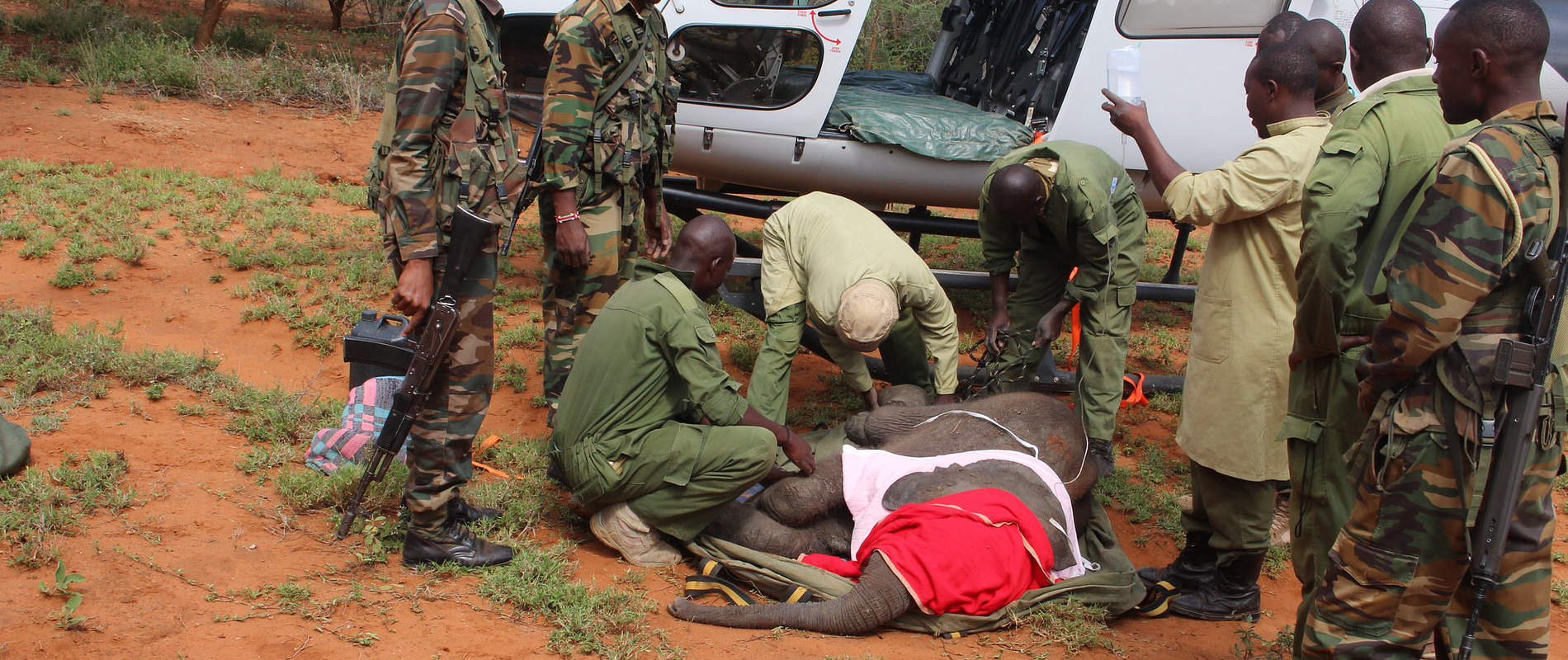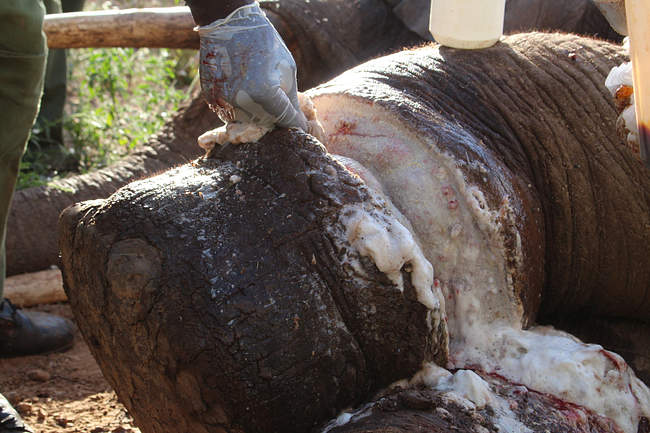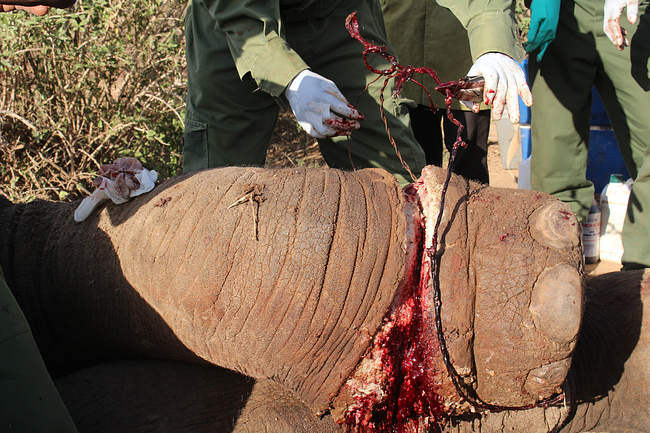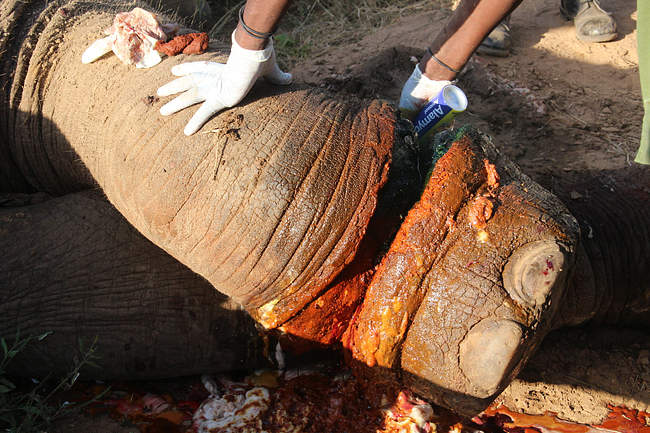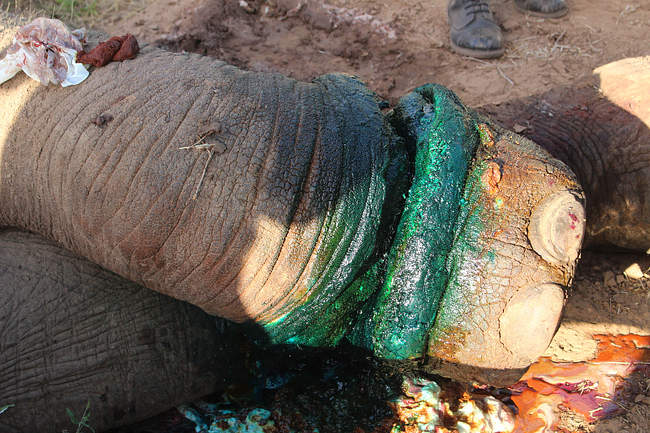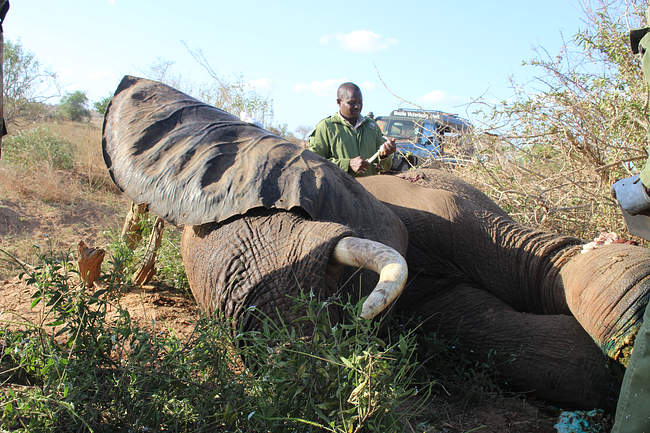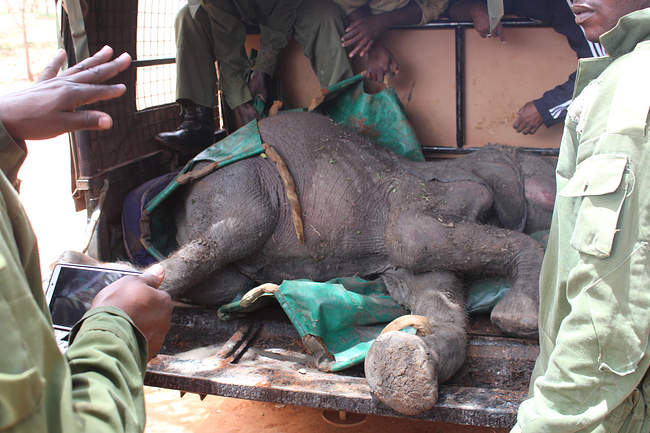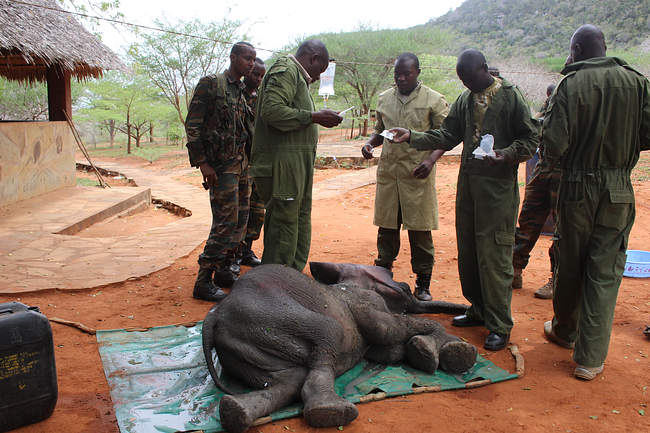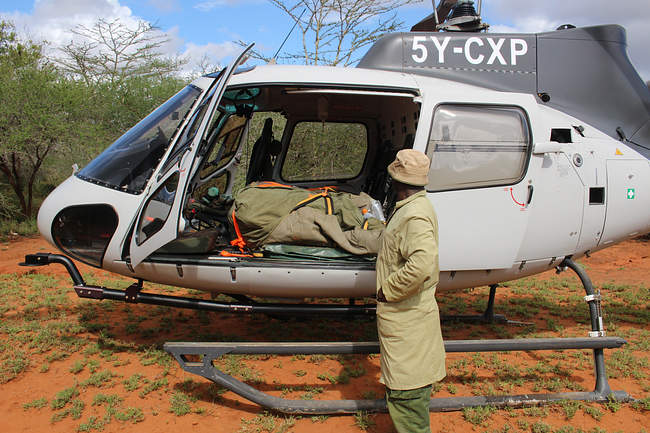During the month of September 2018, despite being dry, the Tsavo Veterinary Unit attended to a moderate number of cases, similar to those handled in August.
Many of the cases involved autopsies of elephant carcasses from suspected poaching incidents along the Western border of Tsavo West National Park near Ziwani area. In the month under review three (3) male elephant carcasses were examined near Ziwani area and one (1) young bull carcass was examined near Ngulia Rhino Valley, all in Tsavo West National Park.
Other cases were an elephant bull treated for a tight wire snare of the left front limb near Sala’s Gate, an orphaned elephant calf rescued in Kilibasi area and another elephant calf rescued near Tiva River, both inside Tsavo East National Park and both were taken to the DSWT Orphanage in Nairobi. A member of the Veterinary team also testified at Makindu Law Courts after examining wildlife trophies confiscated from suspects.
CASE#1 ELEPHANT AUTOPSY
Date of Death: Unknown (Carcass estimated to be 3 weeks old)
Date of Autopsy: 2nd September 2018
Species: Loxodanta Africana (African Elephant)
Sex: Male
Age: Adult
Location: Ziwani, Tsavo West National Park
Introduction: After an aerial recce, a report was made by the company commander, based at Tsavo West National Park that an elephant carcass was spotted near Salaita area. An autopsy was immediately requested, and the Vet Unit travelled to the area by road.
General examination: The carcass was lying on the left flank and was at an advanced stage of decomposition and had been extensively scavenged. The front of the face had been chopped off with a sharp object and the tusks were missing. The chest, abdominal and the perineal area skin had been torn away by scavengers and all internal organs had either rotted away or been scavenged on. The Bones were checked and only scavenger bite marks could be observed.

The skull was checked for cracks but none were found apart from the damage on the front of the face from the cut. No signs of infection on the carcass were discerned from the remains of the elephant’s digestion and parts of the carcass that were not scavenged on. There were no struggle marks around the carcass.
Post-mortem diagnosis: The cause of death could not be diagnosed from autopsy due to advanced autolysis and the carcass being extensively scavenged.
CASE#2 ELEPHANT BULL TREATMENT
Date: 6th September 2018
Species: Loxodanta Africana (African Elephant)
Sex: Male
Age: Adult
Location: Sala gate, Tsavo East
History: A report of a lame elephant bull that was struggling to walk near Sala’s Gate area of Tsavo East was received from the platoon commander at Emusaya KWS Camp. The Vet Team visited the conservancy and found the obviously lame elephant struggling to climb up the Galana River bank after drinking water. Preparation was made to treat the elephant.
Immobilization, examination and treatment: Darting equipment and drugs were prepared containing 18 mgs of M99 in a 1.5 cc dart barrel. The elephant bull was approached using a vehicle and darted with 16 mgs of Etorphine propelled by a dan inject dart system and she went down after 7 minutes.

The trunk and the ear were positioned correctly to aid in breathing and temperature control. The elephant had a deep snare wound around the lower left front limb with swelling and pus formation. The wire was so deep it took about 15 minutes to cut it loose which led to bleeding of the wound.
After the wire was removed, the wound was cleaned by use of water mixed with Hydrogen Peroxide, then doused with Tincture of Iodine, sprayed with Oxytetracycline topical wound spray and finally covered with green clay. Long acting antibiotics were administered intramuscularly and Dexamethasone Hcl was administered intravenously through the ear. Vitamin B12 complex was also administered intramuscularly.
Reversal and prognosis: The anaesthesia was reversed the elephant stood up and walked away slowly. Prognosis for full recovery is guarded.
CASE#3 RESCUE OF AN ELEPHANT CALF
Date: 9th September 2018
Animal: African Elephant
Species: Loxodanta africana
Sex: Male
Age: 1 year
Location: Kilibasi, Tsavo
History: During the dry season, like the current one, elephants search for water in all possible areas including water dams constructed by herders to store water for use by their livestock. In this case, the elephants went to a dam near Kilibasi Trading Centre which was already drying up and filled with deep amounts of muddy water.
They left the dam leaving behind a one year old calf that was unable to free himself from the muddy water, nearly drowning. On spotting the distressed calf, the local community contacted the KWS Rangers manning the vast Taita Ranches who in turn contacted the Vet Team. We rushed to the area to find the nearly submerged calf hanging on for dear life.

Rescue and treatment: The calf was pulled out of the mud and taken to a nearby KWS Camp. He couldn’t stand and further examination revealed that the calf was exhausted and in shock. The Vet administered 20cc of long acting antibiotics intramuscularly, and then the calf was given Dexamethasone 15 cc intravenously and fluid therapy was initiated. The Vet slowly administered 60cc of 50% dextrose intravenously and fluid transfusion of normal saline and ringers lactate was given.
After 30 minutes the calf woke up and had to be restrained. A DSWT helicopter arrived shortly thereafter and the calf was loaded for transport to the DSWT Nairobi Nursery where he will receive better care for eventual release back to the wild.
Our Mobile Vet Units are in the field every day saving wild lives
CASE#4 ELEPHANT AUTOPSY
Date of Death: Unknown (Carcass estimated to be 3 weeks old)
Date of Autopsy: 19th September 2018
Species: Loxodanta Africana (African Elephant)
Sex: Male
Age: Adult (Over 40 years)
Location: Ziwani, Tsavo West National Park
Introduction: A report was made by the company commander based at Tsavo West National Park that two Elephant carcasses had been spotted within Ziwani area of Tsavo West National Park with request of autopsy to be undertaken. The Vet Unit travelled to the area to perform the post-mortem examination.
General examination: The carcass was lying on the right flank facing southerly direction with the second carcass about 20 meters away. It was in advanced stages of decomposition with extensive scavenger activity on the carcass. The carcasses were covered with twigs. The front face had been chopped off with a sharp object and the tusks removed.

Most parts of the limbs had either been scavenged or had decomposed with only part of the left front limb remaining. Most of the skin was intact with nearly all internal organs either rotten away or scavenged. Bones were checked and only scavenger bite marks were observed. The skull was checked for cracks but none were found apart from the cut damage on the front. The trachea and parts of the carcass that were not scavenged on appeared normal. There were no struggle marks around the carcass.
Post-mortem diagnosis: The cause of death could not be found on autopsy due to advanced autolysis and due to the carcass being extensively scavenged.
CASE#5 ELEPHANT AUTOPSY
Date of Death: Unknown (Carcass estimated to be 3 weeks old)
Date of Autopsy: 19th September 2018
Species: Loxodanta Africana (African Elephant)
Sex: Male
Age: Adult (Over 40 years)
Location: Ziwani, Tsavo West National Park
Introduction: A report was made by the company commander based at Tsavo West National Park that two Elephant carcasses had been spotted within Ziwani area of Tsavo West National Park with request of autopsy to be undertaken. The Vet Unit travelled to the area to perform the post mortem examination.

General examination: The carcass was lying on sternal position facing westerly direction with the first carcass about 20 meters away. It was in an advanced stage of decomposition had been extensively scavenged. The front face had been chopped off with a sharp object and the tusks were missing. Most parts of the limbs had either been scavenged or decomposed with only long bones and ribs intact. The two elephants seem to have died at the same time period. The scavengers had emptied all the internal organs and tissues. The trachea and part of the carcass that was not scavenged on appeared normal. There were no struggle marks around the carcass.
Post-mortem diagnosis: The cause of death could not be found on autopsy due to advanced autolysis and due to the carcass being extensively scavenged.
CASE#6 ELEPHANT CARCASS AUTOPSY
Date of Death: Uknown (Carcass estimate 3 days from death)
Date of Autopsy: 23rd September 2018
Species: Loxodanta Africana (African Elephant)
Sex: Male
Age: Sub-adult
Location: Ngulia bandas, Tsavo West National Park
Introduction: A report was received from the company commander of an elephant carcass spotted within Ngulia Rhino valley area of Tsavo West National Park with request of autopsy to be undertaken. The vet unit drove to the area to perform the autopsy.

General examination: The carcass was facing down slope with the tusks removed by KWS Rangers already. The perineal and the abdominal area had been eaten away by scavengers. Most internal organs had been scavenged with few organ parts remaining. The flanks and the back skin cover were intact apart from a penetrating wound at the back. The deep wound went between the scapula bone and the rib cage in a rostroventral angle causing extensive muscle damage and infection. The size of the injury and extent of tissue damage suggested use of a spear to inflict the injury.
CASE#7 RESCUE OF AN ELEPHANT CALF
Date: 23rd September 2018
Animal: African Elephant
Species: Loxodanta africana
Sex: Male
Age: 1 year
Location: Tiva River, Tsavo East
History: The calf was spotted along Tiva River after tracks of a lone small elephant led Rangers to where he was. He was found alone, weak and with no herd anywhere nearby.

After assessment it was deemed good to rescue him on animal welfare grounds. The elephant calf was rescued and taken to DSWT Ithumba Reintegration Unit where he was stabilised and given milk before being airlifted to the DSWT Nairobi Nursery for better care.
OTHER ACTIVITIES
The unit examined several wildlife trophies/parts brought in from Makindu and Voi and testified in the two courts on two cases.
Acknowledgement
Report by KWS Vet Dr Poghon. The unit acknowledges the support of its sponsors ViER PFOTEN through the David Sheldrick Wildlife Trust (DSWT) for their immense financial contribution to the unit. We also thank Kenya Wildlife Service through the Assistant Director Tsavo Conservation area and the head Veterinary and Capture Servicesdepartment for their support.
